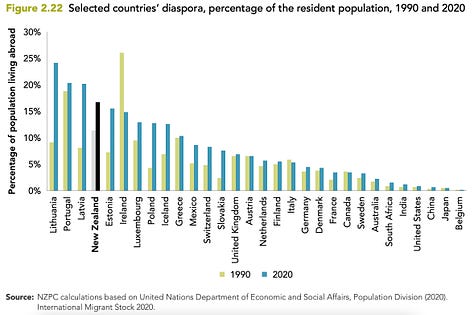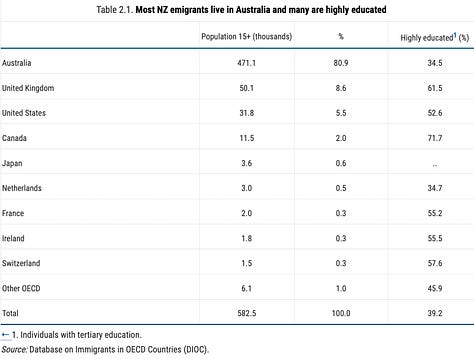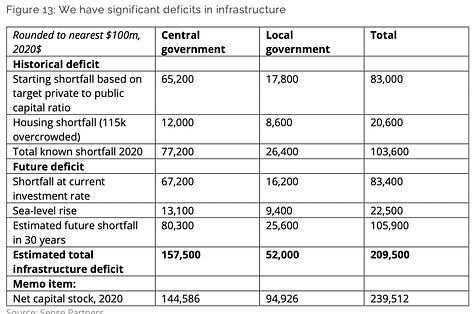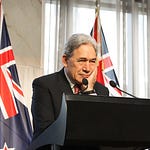TLDR: A Labour Government behind in the polls and facing complaints from businesses and landowners about high inflation and rising interest rates has just done what both flavours of politicians have done for 20 years when the pressure goes on: pulled the migration lever hard to juice growth in a low-inflationary way without building the infrastructure first.
It’s our version of Groundhog Day in Aotearoa’s political economy, and it’s exactly what most business owners, employers, landowners, Treasury officials and median voter want: a surge of population-fed nominal GDP growth that:
lowers wage inflation and boosts profits;
increases tax revenues and lowers budget deficits and borrowing;
lowers interest rates more than would otherwise be the case; and,
puts a springy floor under land prices.
From a political point of view, it’s ‘job done’ by the Government before everyone clocks off for the year and has the barbecue conversations about who to vote for next year. But it only deals with our structural problem in the shortest of short-terms, and only in the most politically and economically myopic way. This third easing of migration settings in five months shows again how neither Labour nor National want nor are able to to address the core flaw in our political economy.
Labour’s determination to address the infrastructure shortage through tighter migration settings, rather than higher taxes, debt and investment, lasted just a few months.
Aotearoa Inc hasn’t invested nearly enough in housing, water and transport infrastructure to cope with past population growth, let alone future growth. Yet politicians, residential land owners and median voters can’t seem to envisage a different way of getting ahead than staying addicted to tax-free gains from land ownership enabled by low taxes, low investment, extractive low-wage industries and a constant flow of mostly cheap migrant labour. Renters can go jump, which they have started to do in rising numbers: across the Tasman.
Plus ça change, plus c'est la même chose.

I detail and analyse last night’s major loosening of migration settings in the podcast above and below the paywall fold for paying subscribers, including audio of my exchanges in the news conference with PM Jacinda Ardern and Immigration Minister Michael Wood. Paying subscribers voted to opened this up for public reading, listening and sharing later. It is now open for public reading and sharing. Many thanks to subscribers for supporting my public interest journalism on housing, climate and poverty in Aotearoa.
Right back to flushing out locals & sucking in new workers
On Monday night the Labour Government loosened migration settings for the third time in five months in an attempt to juice population and economic growth at the same time as taking wage pressure off employers, inflation and interest rates more generally.
The changes detailed in this announcement include:
expanding the 'Green List' for work-to-residency visas to include nurses, construction workers, gasfitters, drainlayers, crane operators, halal slaughterers, mechanics, telecommunications technicians and teachers;
expanding the juicier straight-to-residency visa Green List to include midwives, a wider variety of doctors, and auditors;
offering bus and truck drivers a "time-limited residence pathway" through a sector agreement;
automatically extending employer accreditation by 12 months if their first accreditation is applied for by 4 July 202;
introducing a streamlined Specific Purpose work visa to help keep the approximate 2,500 long-term critical workers already in the country to continue to work in their current role for up to three years; and,
providing a 12-month Open Work Visa for approximately 1,800 previous holders of Post Study Work Visas who missed out because of the border closure in 2020-21 during the COVID-19 pandemic.
PM Jacinda Ardern used her last post-Cabinet news conference of the year to announce the changes alongside Immigration Minister Michael Wood and faced repeated questioning about why the Government had delayed the inclusion of nurses on the Green List after almost a year of calls for a relaxation.
Ardern said she wanted to make New Zealand the most attractive place in the world to live. She did not mention housing costs or other costs of living.
"We need to attract skilled workers to our shores with our pay, with our conditions and with certainty. So in discussions with business in sector groups, we're expanding on our plan to make New Zealand the most attractive place in the world to live.
“That's why today we're announcing the expansion of the Green List, which provides two fast tracks to residency to help attract people to New Zealand and fill labor shortages." Jacinda Ardern in post-Cabinet news conference (transcript)
Ardern and Wood said they did not have advice on the potential number of new migrants the changes would create, or the likely economic impacts on inflation, unemployment, rents or house prices.
They pointed to recently low-to-negative net migration to justify the loosening of the settings, although overall inward net migration has picked up in recent months, particularly of non-New Zealand citizens offsetting the number of New Zealanders leaving to live permanently in Australia because of wages 30% to 40% higher there. The gap is even larger after housing costs, where rents and housing costs are a lower share of disposable income in Australia than New Zealand.
Rebalance? More like a see-saw.
The latest changes are the third set of loosenings in five months, including a reopening of the skilled migrant category for residency visas in October (see story here) and a loosening in August (see story here) to cut the wage rules for years for the aged care, construction, meat processing, seafood and adventure tourism sectors, and to double the cap for working holidaymakers, who can work for anything above the minimum wage.
That first loosening came just 100 days after the Government launched an immigration ‘rebalance’ designed to limit the number of migrants, given the Government has said it is not prepared to invest in the $200 billion of infrastructure the Infrastructure Commission has recommended, if population growth continued at recent rates. That determination to address the infrastructure shortage through tighter migration settings, rather than higher taxes, debt and investment, lasted just a few months.
Wood said the whole world was experiencing labour shortages right now and the Government had listened to business requests for more opportunities to recruit internationally.
“We have approved over 94,000 job positions for international recruitment, granted over 40,000 working holiday visas, reopened the Pacific Access Category and Samoa Quota, delivered the largest increase in a decade to the RSE scheme, and resumed the Skilled Migrant Category and Parent Category so as to strengthen our international offering – but there is more we can do to support businesses to attract the workers they need.
“New Zealand’s strong economic position during a time of global downturn presents a unique opportunity to attract more high skilled migrant workers to our shores, as we prepare for a challenging year ahead. We understand that labour shortages are the biggest issue facing New Zealand businesses, and are contributing to cost of living pressures too.
"These measures are about addressing those shortages and providing greater certainty to businesses as they recover from the pandemic." Michael Wood in a statement.
334,000 work and residence visas approved, and RSE expanded
Wood said the Green List would be reviewed again in mid-2023.
The 134,000 migrants approved to come in over the next year adds to the 200,000 migrant workers granted residency because they stayed here during Covid 19. In September, Wood also increased the annual quota for temporary Registered Seasonal Employee (RSE) scheme workers from Vanuatu, Fiji, Samoa, Tonga, the Solomon Islands and Tuvalu by 3,000 to 19,000, which was the largest increase in over a decade.
This latest loosening came on the same day the Equal Employment Opportunities Commissioner, Saunoamaali’i Karanina Sumeo, published a scathing report on the RSE scheme that called for a proper review and removing the tying of a worker to an employer through the visa, which is the common practice for other temporary work visas as well.
“It has been absolutely distressing to witness the living conditions, exploitative practices and the apparent disrespect on the mana, collective and cultural identity of the workers that are coming from the Pacific to work in our industries here.
“We know there are systemic human rights issues that need to be addressed under the RSE scheme.
“Our engagements with RSE workers have revealed serious gaps in the scheme, which may enable a systemic pattern of human rights abuses throughout the country.”
“What’s become quite clear is that due to a lack of oversight, regulation, enforcement, and human rights protections within the RSE scheme, employers are able to exploit workers with few consequences if they wish.” Equal Employment Opportunities Commissioner, Saunoamaali’i Karanina Sumeo in a report on the scheme.
So why can’t we kick the addiction?
Aotearoa Inc hasn’t invested nearly enough in housing, water and transport infrastructure to cope with past population growth, let alone future growth. Collectively, we still won’t or can’t invest enough in infrastructure, business assets and training to deliver the productivity boost needed to create real wage growth after housing costs are taken into account.
We also haven’t touched the hairy bits of the biggest of elephant in the room of our political economy. We haven’t collectively debated or decided how ‘big’ we want our population to be, and whether we want to actually invest for that ‘big’ (or little) Aotearoa.
Our Unholy Trinity
It’s easier to think magically that we can have it all (high GDP and land value growth growth, low taxes, low interest rates and low investment), and hope someone else takes the hard decisions some time in the politically distant future to either lift taxes and investment to lower housing costs relative to incomes, or to limit population growth by restricting migration.
This ends with: ‘Will the last tenant to leave the country tell the one landlord left to turn off the lights?”
This is our own version of the classic Impossible Trilemma or Unholy Trinity, which refers to the impossibility of having a fixed exchange rate, independent monetary policy and free movements of capital all at once.
Ours goes something like this: we can’t have fast migration-led population and GDP growth without significantly higher taxes and debt for investment in infrastructure, and we can’t have it while keeping gains on land values tax-free and allowing free movements of workers across borders. In the end, something has to give. Either the congestion and land value inflation drive renters out of the country and makes attracting migrant labour difficult, or the constant under-investment drags down real after-housing-cost wages to levels that make attracting migrant or local labour difficult.
This ends with: ‘Will the last tenant to leave the country tell the one landlord left to turn off the lights?”
At the moment, residential land owners think they can have it all, thanks to the encouragement of politicians from both main parties who are loathe to propose higher taxes (especially land or capital gains taxes) or congestion charges for infrastructure, or higher public debt levels that would push up interest rates and push down land values. Like any addict reluctant to take some short term pain for long term gain, median voters think just one more hit of migration will solve it all.
Flushing young renters out and replacing them with residency hunters
Meanwhile, the young renters who grew up here without land-owning parents are left wondering if anything will ever be done to lower the highest housing costs in the world in a way that allows them to save for their own homes and put their roots down here. The option to simply leave for much, much higher disposable incomes after housing costs in Australia looks ever more attractive at a time the Australians actually want to welcome Kiwis in with open arms to be permanent Australians.
Those young people who grew up here are then replaced by migrants, skilled or otherwise, who either are moving here because either our lifestyles are better than the polluted, dangerous and corrupt big cities of India, the Philippines, South Africa and beyond, or they haven’t worked out just how brutal our housing costs are. The third rarely-spoken-of option is that they see New Zealand as a residency mill to give them the ultimate holy grail: residency in Australia. Ironically, that option becomes much more viable and valuable if, as now seems likely, Australia follows through on its promise from earlier in the year to treat New Zealanders there as first class residents for the first time in two decades. See more on that here in yesterday’s podcast/article.
Our young are voting with their boarding passes
The outflow of locals is on in earnest, and not just from ‘catch-up’ OEs. There have been 12 consecutive months of net migration losses of New Zealand citizens to October 2022, amounting to 15,100 over the year, Statistics NZ reported yesterday. This follows 27 months of mainly net migration gains of New Zealand citizens, amounting to 32,100. Effectively, half of those that came home have already left again.
Australia is the main destination. There was a provisional net migration loss of 7,500 people to Australia in the year ended March 2022. This was made up of 15,300 migrant arrivals from Australia to New Zealand, and 22,800 migrant departures from New Zealand to Australia.
Traditionally, there has been a net migration loss from New Zealand to Australia. This averaged nearly 30,000 a year during 2004–2013, and about 3,000 a year during 2014–2019. That means net migration as of the end of March is already running at twice the ‘normal’ rate seen in the six years before covid. Provisional figures to the end of of October suggest we’re already headed back to those dark old days from 2003 to 2013.
Remember John Key’s comments in the 2008 election campaign about the 36,000 New Zealanders, a full Wellington Stadium’s worth, who had left to live in Australia? Or then Labour Leader David Shearer’s comments in 2012 that Key had turned New Zealand into a “finishing school for future Australians” when 50,000 New Zealanders migrated in a year. This chart shows net migration of New Zealand citizens to Australia up to the end of March this year.
As this series of charts show, this is not new and is a result of more than 30 years of under-investment, which has seen a constant outflow of our most educated and skilled to live permanently overseas. By 2019 we had the third biggest diaspora in the OECD relative to our population, along with the highest share of temporary workers in the OECD. The charts below are from papers from the OECD, Productivity Commission and World Bank.









It’s all because we invest less than most
This series of charts from papers by Sense Partners for the Infrastructure Commission and Infometrics show how Aotearoa has underinvested since the mid-1970s and especially from the 1990s onwards as Governments pivoted towards lower taxes (and no tax on capital gains), lower investment and reinvesting less than depreciation levels.









So surely the Government thought about this? Seems not.
I asked Ardern and Wood at the news conference why they were going ahead with another loosening of migration settings when they had no advice about the likely effects on inflation, rents, employment or infrastructure shortages. You can hear the exchanges in the podcast above.
Essentially, as with National, which is promising a migration surge and also has no plans to ramp up infrastructure investment, they have both chosen not to address the population vs growth vs infrastructure Impossible Trilemma.
Magical thinking rules. Ok?
I’ve written in depth on this today, if only to reinforce my questions about the magical thinking about the Impossible Trilemma. Would paying subscribers like it opened up? Please vote and/or comment below.
News elsewhere here and overseas last night and today:
Who knew what when - Local Government Minister Nanaia Mahuta knew about a Green plan to entrench state ownership of Three Waters assets a month before she had previously said she did, Thomas Coughlan reported this morning; NZ Herald
Onslow decision delayed - Energy Minister Megan Woods has confirmed Cabinet has delayed a decision on progressing with the $4 billion-plus hydro battery scheme in central Otago from before-Christmas until after the New Year; Stuff
‘Not available for comment’ - Russia’s President Vladimir Putin cancelled his usually-huge annual news conference in Moscow at late notice, suggesting intense pressure within the Kremlin over his Ukraine war debacles; and,
Fusion power breakthrough - The FT-$$$ reported yesterday US government scientists had made a breakthrough in the pursuit of limitless, zero-carbon power by achieving a net energy gain in a fusion reaction for the first time.
Ka kite ano
Bernard














Share this post